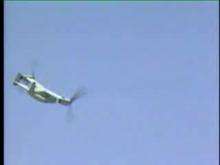Counter-rotating propellers




Counter-rotating propellers, also referred to as CRP,[1] found on twin- and multi-engine propeller-driven aircraft, spin in directions opposite one another.
The propellers on both engines of most conventional twin-engined aircraft spin clockwise (as viewed from behind the engine). Counter-rotating propellers generally spin clockwise on the left engine and counter-clockwise on the right. The advantage of such designs is that counter-rotating propellers balance the effects of torque and P-factor, meaning such aircraft do not have a critical engine.
In designing the Lockheed P-38 Lightning, the decision was made to reverse the counter-rotation such that the "tops" of the propeller arcs move outwards, away from each other. Tests on the initial XP-38 prototype demonstrated greater accuracy in gunnery with the unusual configuration. The counter-rotating powerplants of the German World War II Junkers Ju 288 prototype series (as the Bomber B contract winning design), the Gotha Go 244 light transport, Henschel Hs 129 ground attack aircraft, Heinkel He 177A heavy bomber and Messerschmitt Me 323 transport used the same rotational "sense" as the production P-38 did - this has also been done for the modern American Bell Boeing V-22 Osprey tiltrotor VTOL military aircraft design.
Drawbacks of counter-rotating propellers come from the fact that, in order to reverse sense of rotation of one propeller, a gearbox needs to be used or the engine installation must be different. This may increase weight (gearbox), or maintenance and spare parts costs for the engines and propellers, as different spare parts need to be produced in lower numbers, compared to a conventional installation.
Opposing-rotation aircraft propellers that share a common axis are known as contra-rotating propellers, rather than counter-rotating.[2]
The following aircraft have counter-rotating propellers:
Single engine, roller chain driven propellers (one chain's path crossed to enable counter-rotation):
- The Wright Flyer — and nearly all aircraft designed and built by the Wright Company (1909-1916)
Twin-engine, one engine per wing :
- Beechcraft 76 Duchess
- Bell Boeing V-22 Osprey tiltrotor
- Cessna T303 Crusader
- de Havilland Hornet
- Fokker G1 prototype [3]
- Heinkel He 177A Greif (fourth prototype onwards)
- Henschel Hs 129
- Gotha Go 244
- Junkers Ju 288
- Lockheed P-38 Lightning
- Piaggio P.180 Avanti
- Piper PA-31 Navajo (some variants)
- Piper PA-34 Seneca
- Piper PA-39 Twin Comanche C/R
- Piper PA-40 Arapaho
- Piper PA-44 Seminole
- Vought V-173 Flying Pancake
At least four engines, two or more on each wing :
- Messerschmitt Me 323 Gigant transport
- Airbus A400M Atlas - first aircraft with propellers in counter-rotating pairs on each wing
The following German World War II aviation engines were designed as opposing-rotation pairs for counter-rotation needs:
- BMW 801A and B, and G/H subtypes
- Daimler-Benz DB 604
- Daimler-Benz DB 606
- Daimler-Benz DB 610
- Junkers Jumo 222
See also
References
- ↑ Counter-rotating propellant analysis using a frequency domain panel method
- ↑ Hitchens, Frank (2015-05-11). "4". Propeller Aerodynamics: The History, Aerodynamics & Operation of Aircraft Propellers. Andrews UK Limited. ISBN 9781785381256.
- ↑ Fokker G1 jachtkruiser deel 1 ISBN 978-90-8616-110-2 https://books.google.com/books?id=frpCywAACAAJ&dq=Fokker+G1+jachtkruiser&hl=nl&sa=X&ved=0ahUKEwigr8Ow5fLNAhVPrRQKHWKEB_AQ6AEIHjAA